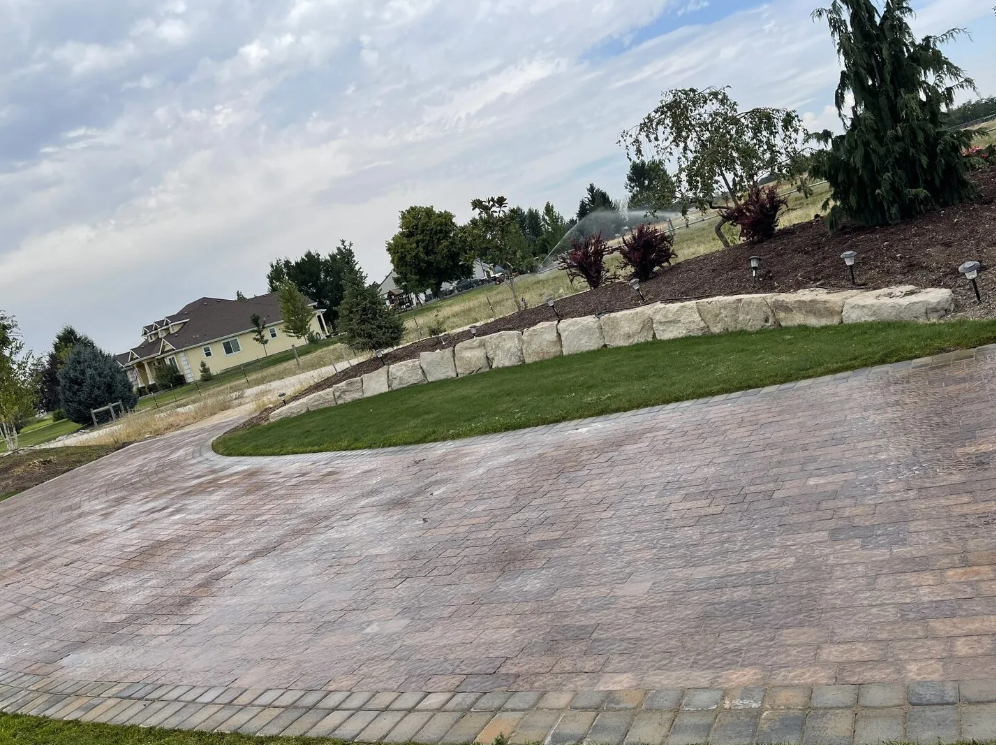Pavers with lasting structural integrity
Pavers in Boise ID may look beautiful on the surface, but their true strength comes from what’s built underneath them.
A homeowner in Boise finally completes their dream patio. The design is beautiful, the pavers are perfectly aligned, and the curb appeal is undeniable. But six months later, after a harsh winter and a few heavy rains, problems begin to show. Some pavers have started to shift. Water pools in low spots. Edges look like they’re unraveling. It still looks good from a distance, but the issues underneath are now impossible to ignore.
This is the difference between a hardscape that merely looks good and one that’s built to last. Most people assume that paver installation is just a matter of laying bricks on the ground. In reality, the quality and longevity of any paver project hinge on what’s beneath the surface, work that is invisible but absolutely essential.
The Real Secret to Long-Lasting Pavers
When people ask, “Will my pavers sink, shift, or crack over time?” the honest answer is: it depends entirely on the foundation. A properly engineered paver system won’t fail due to weather, time, or wear, especially in a place like Boise where freeze-thaw cycles and clay-heavy soils pose unique challenges.
Let’s break down the critical, behind-the-scenes engineering that separates professional-grade paver installations from temporary cosmetic fixes.
- Sub-Base: The Backbone of Every Paver Project
The sub-base is the thick layer of aggregate that sits below your pavers and base sand. It’s not optional. In fact, it’s the most important structural component of the system.
For residential patios or walkways in Boise, the minimum recommended sub-base depth is usually 4 to 6 inches. For driveways or areas that will support vehicles, that depth jumps to 8 to 12 inches. This depth must be adjusted depending on soil conditions, expected load, and regional factors like Boise’s winter weather.
If that layer isn’t deep enough, or worse, not compacted correctly, the pavers above will eventually sink, separate, or shift out of alignment.
- Proper Compaction: Eliminating the Risk of Settling
After placing the aggregate, compaction must be done using a plate compactor in multiple passes. Professionals use 95% compaction standards, which means the ground is nearly as dense as it can possibly get without causing deformation.
This process ensures no future settling occurs. Without this, even the most expensive pavers can end up uneven after just one season.
- Drainage Strategy: Keeping Water Where It Belongs
Water is the biggest threat to any paver installation, especially in Boise where melting snow and rain can saturate the soil rapidly. That’s why a smart drainage plan is critical.
There are two main elements to this:
- Proper slope grading: Paver surfaces should be pitched at about 2% away from buildings to direct runoff.
- Permeable base layers and drainage pipes (where needed): These help move water away from the foundation and prevent it from collecting beneath the pavers.
Without these strategies, water collects underneath, eroding the base and encouraging freeze-thaw expansion that causes cracking and lifting.
- Geo-Textile Fabric: The Unsung Hero
Another invisible but vital component is geo-textile fabric, placed between the native soil and the aggregate sub-base. This durable fabric prevents the aggregate from mixing with the soil over time, which can destabilize the entire structure.
In Boise, where clay content can vary greatly between neighborhoods, using this layer helps keep the foundation clean and dry, increasing the system’s durability.
- Edge Restraints: Guarding Against Horizontal Shift
While many articles focus on surface aesthetics and layout patterns, edge restraints are what keep everything in place. These are mechanical or concrete boundaries installed at the outer perimeter of the paver field.
Without edge restraints, pavers gradually move outward under pressure and use. With them, your patio or driveway maintains tight seams and clean lines for decades.
- Joint Sand and Sealing: Finishing Strong
Once pavers are laid and compacted, polymeric joint sand is swept between the joints and then activated with water. This material locks the pavers in place while also preventing weed growth and ant intrusion.
In some cases, a high-quality sealant may also be applied. This not only enhances color but also protects against staining and water penetration, both common issues during Idaho’s seasonal shifts.
The Boise Climate Factor
Boise experiences freeze-thaw cycles, moderate snowfall, and occasional downpours, all of which can wreak havoc on poorly constructed hardscapes. That’s why materials and methods used in Arizona or California don’t always translate here.
Here in Idaho, building to local conditions isn’t optional, it’s required if you want the results to last. That’s why the most durable paver systems are the ones that prioritize what’s beneath the surface just as much as the surface itself.
Our Approach at Premier Hardscape Systems
At Premier Hardscape Systems, we don’t cut corners. Every single paver project we take on is built on a foundation of structural integrity. We apply geo-textile fabric to stabilize soil, engineer our sub-base to local standards, and compact with precision.
Drainage is never an afterthought. We evaluate slope, water runoff, and local soil absorption rates to make sure your paver system handles Idaho weather, not just this year, but every year after.
Our team follows a strict process that blends beauty with strength. We know that when you invest in pavers, you’re not just buying a surface. You’re building a long-term solution for outdoor living, functionality, and home value.
When you work with us, you get more than a pretty patio. You get peace of mind that what we’ve built together is going to stand strong for decades.
Frequently Asked Questions (FAQs)
Q: How deep should the base be for pavers in Boise, ID?
A: For patios and walkways, a 4 to 6-inch base is typical. For driveways, 8 to 12 inches is recommended, depending on soil and expected load.
Q: Do I really need geo-textile fabric under my pavers?
A: Yes. It prevents the base materials from mixing with soil, which keeps the structure stable and extends the lifespan of your project.
Q: How do you make sure water doesn’t damage my pavers?
A: We grade the surface away from structures, use permeable base materials, and install drainage solutions tailored to your site.
Q: What causes pavers to sink or shift over time?
A: Poor compaction, inadequate base depth, water intrusion, and lack of edge restraints are the most common culprits.
Q: How long will my pavers last with proper installation?
A: With the right engineering and maintenance, pavers can last 25 to 30 years or more.
Pavers aren’t just about aesthetics. They’re about strength, planning, and preparation. What you don’t see, the base layers, the compaction, the drainage, is what truly determines how long your investment lasts.
At Premier Hardscape Systems, we build paver systems from the ground up, literally. Our process is detailed, our standards are high, and our results are built to last, not just for seasons, but for lifetimes.
Top Boise Idaho Hardscaping and Landscaping Services
Providing Boise Idaho and surrounding areas with hardscape and landscaping services with over 2 decades of experience. When you want the very best, contact Premier Hardscape Systems, 208-286-5197.

